
|
Battle of the Atlantic
The Tide Changes
By 1942, the decisive phase of the Battle of the Atlantic was at hand. As this phase of the war opened, the technical balance on both sides was about even. Great strides in technology allowed both the Germans and the Allies to raise the notch in the stakes of the Atlantic.
In Germany, the cipher battle continued with B-Dienst, the German code-breaking division breaking the British “Naval Cipher No. 3”. The Germans were able to read significant amounts of British coded messages, providing a great deal of intelligence to BdU. Daily convoy routes were known well in advance, allied estimates of enemy dispositions and other intelligence information gleaned from coded messages allowed BdU to wage a much more effective campaign. This resulted in the interception of ten convoys from August to October 1942. By 1943, intercepted messages had become such a rich source of intelligence, that U-boat deployments were based almost exclusively on the analysis of British messages.
The Germans also had another advantage in the cipher war. In February 1942, under Donitz’s insistence, a fourth wheel was added to ENIGMA, their mechanical ciphering apparatus. The British again lost their ability to read German coded messages until December of 1942, when the ENIGMA was broken again. During this time, the Allies were deprived of valuable intelligence and were unable to route convoys away from the U-boats.
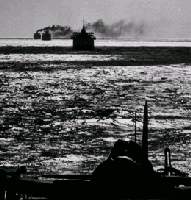
|
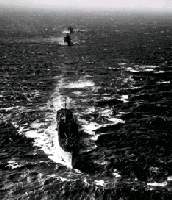
|
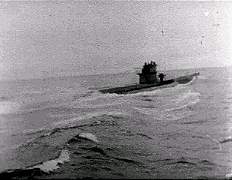
|
| A convoy strung out under the protection of an escort carrier. | A convoy column knives across the Atlantic. These were the lifelines of the Allied war in Europe. | An unknown U-boat heading for a replenishment at sea. |
Advancements were also made in German radar warning receivers. After a series of peculiar night time attacks by allied aircraft, Admiral Donitz reacted quickly by making Metox – a recently developed radar detector – a part of every U-boat. Mounted on a wooden cross and attached to the conning tower of a surfaced boat, the Metox, nicknamed the “Biscay Cross” recognized radar signals and transmitted that information to a shipboard receiver, alerting the crew to the presence of a radar equipped aircraft in the vicinity. This new device made a great difference in the Bay of Biscay, the one area where all U-boats had to cross in order to get to their French bases. Allied pilots later reported that on more than one occasion, that as the aircraft approached the U-boat, the blimp on the radar would suddenly disappear, foiling the attack. Although U-boat losses were greatly reduced, especially in the initial months, this still benefited the Allies. The U-boats were forced to navigate underwater for extended periods of time, compromising their speed and operational ability.
The next advantage the Germans possessed was the U-tankers. Strategically deployed in a network over the Atlantic, these tankers were known to the crews as “see kuh” or “milk cows”. U-boats could now refuel and re-supply from these tankers, greatly extending their operational coverage and patrol time at sea. Remote areas such as the Indian Ocean and even the South China Sea were now within range of the Type VIIs.
Weaponry was the final area that saw major improvements during this time. New pattern running anti-convoy torpedoes were introduced. The pattern running torpedo was designed to be fired from abeam a convoy, where if the initial straight run failed to hit its target, the torpedo would reverse course and ran a further distance before reversing course again. If this zigzag pattern ran across the path of a convoy, the chances of scoring a hit were greatly increased.
With all these advantages on hand, the Germans seemed poised to gain the upper hand in the control of the Atlantic. But the Allies would not recede so easily to their German foes.
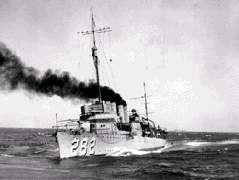
|
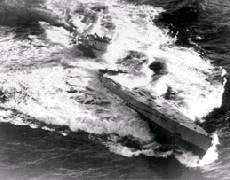
|
| These old vintage American four-pipers from WW 1 would make a critical difference in the Allied effort in World War Two. | A damaged Type IX struggles to stay afloat in the swelling waves of the Atlantic. |
On the Allied front, ship building capacity had reached a peaked efficiency, with the American, British and Canadian Allies building enough escorts to ensure every merchant convoy was adequately protected end-to-end. The large number of Allied ships meant that escorts could be relegated from convoy protection to chase down HF/DF bearings. Even if the pursuing escorts could not sink the U-boat, it would often force it to submerge, making it lose contact with the convoy. These U-boats were often the shadower, and driving the shadower away would prevent a pack from forming against the convoy. The surplus of Allied ships also enabled the formation of several support groups, or anti-submarine strike forces. Unlike escort groups, which sailed with the convoy, these were not assigned to a particular convoy, but would take over the hunt for a U-boat discovered near a convoy. Usually consisting of an escort carrier and destroyers, this new combination was especially potent as they combined the tactics of both aircraft and surface ships. They were relentless in their attacks and were willing to hunt a target for days.
The Allies also added a new weapon to their arsenal. Along with depth charges, they now wielded a ship-borne forward-throwing mortar nicknamed the Hedgehog. The Hedgehog was actually a group of whirling dervish sort of bombs fired ahead of the attacking ship. Each bomb was small but together they created a dense explosive field that proved to be more accurate than depth charges. Despite the Hedgehog’s quickly delivered accuracy many captains showed a particular preference for the more powerful but less accurate depth charge.
The British had recently installed HF/DF (Huff-Duff) sets, an electronic radio detection system on their escorts. With HF/DF the English, using two floating stations, were able to intercept short range U-boat radio transmissions and calculate a submarine’s exact location. The British device was especially accurate for two reasons. First, U-boat captains tended to broadcast long and frequent radio messages when shadowing a convoy, making calculations easy. Additionally, although this technology was not new, prior to 1942 it had only been used at long distance from land stations, but now, they were installed on convoy escorts making calculations more accurate.
Improved radar sets were now available that could pinpoint U-boats on the surface with unheard of accuracy. U-boats conducting nighttime surface attacks were no longer invincible to the escorts. Instead, various nighttime attacks by British aircraft had taken German captains by surprise. The fact that aircraft was nearby was not surprising, however their ability to zero in on a floating sub enjoying the cover of night startled the U-boat crews.
Finally, the Allies introduced long range aircraft with twice the range of those common early in the war and sent aircraft along with their convoys on escort carriers. They were now better equipped – using airborne radar, improved depth charges and rockets. Their long range also extended Allied air cover to areas previously beyond the reach of aircraft. A large part, but not the entire Atlantic, was now covered by aircraft.
When this phase of the war reopened in the summer of 1942, the situation on both sides was about even. By this time, the return of U-boats to the North Atlantic came as no surprise to the Allies. They had understood Donitz’s strategy and had predicted his move well in advance. Nevertheless, this phase of the war would see some of the hardest battles pitted between the U-boats and the Allies.
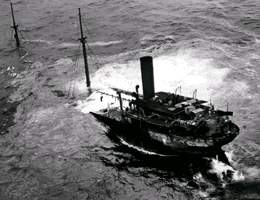
|
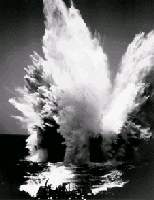
|
| The American merchant, SS FW Abraham sinking. | An exploding depth charge behind an escort vessel. Sonar contact with the sub was lost during this time. |
In the months of July and August, Donitz had managed to deploy only one wolf pack consisting of about fifteen U-boats, but by October, this figure had grown to as many as four wolf packs operating simultaneously. Despite this increasing coverage, the U-boats failed to spot some convoys and did not organize successful attacks on others. Of the 23 convoys intercepted, only three resulted in successful attacks. The Allies had become much better submarine hunters and had the better of the fight. The escorts and destroyers through a combination of air cover and strong escorts fended off the wolf pack, which for the first time, the tide was beginning to show signs of change. The following month of September saw severe storms strength lash the North Atlantic, halting the U-boat campaign against Allied convoys.
Not until late October did a successful pack attack occur. A pack of fifteen boats under Group Violet operating off Newfoundland received a decoded Allied message of convoy SC107. Headed for New York, the forty two ship convoy was strung out in seven columns, protected by five escorts of the Royal Canadian Navy. By midnight of November 1, the pack was in position and the ordeal started. U-402, commanded by Siegfried von Forstner fired the opening salvo to strike the freighter Empire Sunrise amidships, sending her to the bottom. Two more ships would fall victim to the U-402, before Schneider in U-522 followed with another attack. The other U-boats circled and probed, sniping as they went. By the end of the ordeal, fifteen ships had gone down in the battle, the worst mauling of any convoy in 1942. Yet Donitz was not optimistic of the situation. Although the Allies had lost fifteen ships and over 81,000 tons in a single convoy, but the Germans had lost three U-boats during that encounter. This was not a favorable rate of exchange for the U-boats.
Donitz’s frustrations continued into November. As the struggle for the Atlantic grew in intensity, the Allies mounted a secret massive strike, Operation Torch, to retake Africa from Rommel’s forces. Hitler ordered a maximum concentration of U-boats to foil the invasion force, which consequently reduced the number of U-boats available for Atlantic operations. With so few U-boats available, operations in the Atlantic were crippled and the number of ships sunk off the African shore did not justify the diversion of effort away from the main theatre.
As 1943 opened, the Atlantic campaign had all but stopped due a series of hurricane strength storms. But a series of events would soon follow that would change the career of Admiral Karl Donitz. The Admiral had argued for years for a full commitment from the Reich to submarine warfare. And on the last day of 1942 an incident involving the German heavy cruiser Hipper and the pocket battleship Lutzow would drastically change the Reich’s naval strategy.
The Fuhrer was furious when he found out that the two German ships had failed in their attack on a British convoy off the Scandinavian coast. Hitler’s interpretation was that the ships had been too timid, but the Navy’s Grand Admiral Erich Raeder knew they were simply following Hitler’s orders to use caution when intercepting British naval ships. Hitler’s solution was to take the heavy guns from all of the Reich’s attack ships and fortify coastal positions. Raeder would not hear of such a preposterous idea and resigned. Hitler chose Donitz as his next Grand Admiral.
Karl Donitz found himself exactly where he wanted to be – in charge of the lion’s share of the entire Navy’s construction budget. Although he was now the Grand Admiral, he still retained direct control over his U-boat fleet. Along with convincing Hitler to rescind his order to decommission all war ships, Donitz won the German leader’s approval regarding his U-boat strategy. Hitler allocated more steel to the building of submarines and exempted from military service the skilled labor needed to construct the vessels. Soon the shipyards were turning out 30 U-boats a month—the rate for which Donitz spent years arguing.
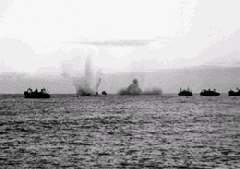
|
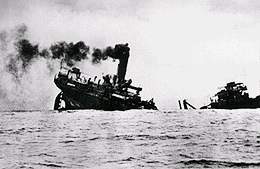
|
| A convoy being mauled by U-boats on November 12, 1942. | With its back broken in two, this freighter would soon rest at the icy bottom of the Atlantic. |
Back on the Atlantic front, convoy battles resumed at the end of January. A pack of five U-boats attacked convoy HX224, two attacks were driven off with the convoy losing only three ships out of 57. February 4th saw a pack of sixteen boats intercept convoy SC118, a sixty three ship convoy bound for the Soviet Union. Guarded by an unusually high number of escorts, the resulting battle was dubbed by Donitz as “perhaps the hardest convoy battle of the entire war”. Eleven ships went down and one seriously damaged. In return, Donitz lost three boats and four were seriously damaged. This rate of exchange did not favor the U-boats.
Donitz was even more displeased when the action against SC118 was analyzed back at BdU. Of the eleven ships sunk, seven had been torpedoed by Forstner and only three others managed to execute successful attacks. This showed that only the most experienced and skillful commanders were capable of defeating the convoy system. Although losses were seemingly high for the U-boats, but thanks to the new construction program, boats could be replaced readily enough. But finding competent crews to run them was another matter. Training time had to be reduced to keep pace with the rapid fleet expansion with the consequence that newer crews were not as highly trained as the older ones had been.
Five other convoy battles raged on throughout February, with the odds more or less even on both sides. By the end of the month, sixty-three Allied vessels with a total of 359,328 tons were lying at the bottom of the ocean. By March 1, 1943, Donitz had about 70 U-boats on station worldwide. Germany had the upper hand during this period with the first ten days of the month seeing forty-one Allied ships being destroyed. As intensity of the battles raged on, the sinkings in the Atlantic was building into a crescendo. In March 1943, the U-boat force would see the high-water mark of their success in the Atlantic.
For five days between March 12 to 17, 1943, the largest convoy battle of the war would see 42 U-boats pitted against over 100 Allied ships along a fluid 600-mile battlefield. Donitz and his fleet of underwater vessels had never experienced such a massive victory. The convoy HX229 and SC122 were mauled and ravaged over a series of attacks. The Allies lost 22 ships which added up to 141,000 tons. The U-boats achieved this with a loss of only one of their own and three severely damaged. The breath of the destruction raised doubts among the Allies whether Donitz had found a way to defeat the convoy system. Adding to the Allied distress was that during the first three weeks of March, ninety-seven escorts and merchant vessels were sunk for a total of 500,000 tons – nearly twice the ship building capacity of the Allies during the same time. Two thirds of those ships went to the bottom when connected to a convoy. The British Admiralty declared, “the Germans never came so near to disrupting communication between the New World and the Old as in the first twenty days of March 1943”.
Despite the heroic victories in March 1943, Donitz knew that the numbers did not even come close in terms of carnage and destruction as what had been recorded in 1940 during what was known as the Happy Time. This was no “happy time” for the underwater naval fleet. In fact, it was merely proof that the champion of the North Atlantic was still undecided.
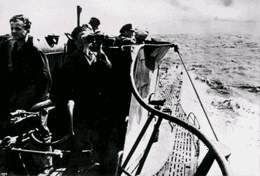
|
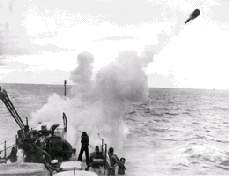
|
| U-boat crews scanning the horizon during an Atlantic patrol | A depth charge leaves its launcher aboard an escort vessel |
The following April month would see four convoy battles, but strong escorts and air cover frustrated attacks on three of these. The U-boats claimed fifty six Allied ships totaling 328,000 tons by the end of the month. Years after the war, many U-boat veterans would state that it was roughly at this point that they knew the Battle of the Atlantic had been lost. Donitz calculated that the Allies were constructing 700,000 tons of shipping per month (the actual figure was 590,000 tons). Many conceded that unless sinkings outstripped Allied construction rates, otherwise the entire effort was merely to stave off the inevitable end.
May 1943 saw another turning point in the battle. A fresh crisis was brought to the Atlantic and with it, came the final proof that the Allies would reign supreme of the shipping lanes. Donitz had, at this time the most number of U-boats ever on station in the North Atlantic - sixty U-boats in four different packs. On May 4, convoy ONS5 sailed directly into one of the packs. In the course of three nights, forty one U-boats attacked, sinking 13 Allied ships and damaged another. But in return, seven U-boats were sunk and another three damaged. On May 11, the Allies fended off another attack, this time on convoy HX237, sinking three U-boats in the process. No ships were lost in the convoy. In all instance, the Allies combined air and sea tactics, with surface ships finishing off its prey, while aircraft hovered above providing vital coordination. Four other convoys were defeated that month. The Allies lost three ships and in the process, sent five U-boats to the bottom.
In all, thirty four U-boats had been lost during the first three weeks, and the final toll for all of May, forty one. An intolerable rate of loss, which spelt defeat for the Reich’s U-boat force. More than 1,000 German sailors lost their lives that month, many of them skilled veterans from the early war, never to be replaced again. The Admiral had lost his own son, Peter, who went down in U-954, during his maiden voyage against convoy SC130 on May 19. The escort system had clearly defeated the U-boats.
On May 24, Donitz was quoted as saying “Wolf-pack operations against convoys in the North Atlantic were no longer possible”. He reluctantly ordered a suspension of convoy attacks and withdrew the wolf-packs to safer waters. A few U-boats would remain to give the enemy the impression of a continuing presence. The Admiral had not believe the battle was lost, but conceded that new advances were needed in order to counter the Allied technological edge. He won more concessions for U-boat construction and support for research and development of new weapons and technology, but until then, the U-boats would have to concentrate only on secondary theater.



